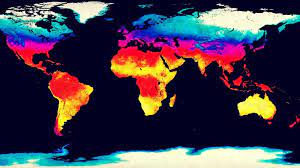The Impact of Climate Change: A Global Challenge
Climate change is one of the most pressing issues facing our planet today. It refers to long-term shifts in temperature and weather patterns caused by human activities, primarily the burning of fossil fuels and deforestation. The consequences of climate change are far-reaching and affect various aspects of our lives, including the environment, economy, and human health.
Environmental Consequences
One of the most evident impacts of climate change is the alteration of ecosystems and biodiversity. Rising temperatures disrupt natural habitats, leading to species extinction and imbalances in ecosystems. Coral reefs are particularly vulnerable to climate change, with increased ocean acidification and rising sea levels threatening their existence.
Extreme weather events such as hurricanes, droughts, floods, and heatwaves have become more frequent and intense due to climate change. These events result in devastating consequences for both human populations and the environment. Coastal regions are at risk from rising sea levels, causing erosion, saltwater intrusion into freshwater sources, and increased vulnerability to storm surges.
Economic Implications
The economic impacts of climate change are extensive. Agricultural productivity is heavily influenced by climatic conditions, with changes in temperature patterns affecting crop yields and food security. Unpredictable weather patterns can lead to crop failures, food shortages, increased commodity prices, and loss of livelihoods for farmers.
In addition to agriculture, industries such as tourism and insurance face significant challenges due to climate change. Natural disasters can damage infrastructure, disrupt travel plans, and increase insurance claims. The costs associated with adapting to these changes or recovering from extreme weather events place a burden on economies worldwide.
Human Health
Climate change poses significant risks to human health. Increased heatwaves can lead to heat-related illnesses and deaths, particularly among vulnerable populations such as the elderly and those with pre-existing health conditions. Changes in temperature and precipitation patterns also affect the spread of infectious diseases, including vector-borne diseases like malaria and dengue fever.
Poor air quality is another consequence of climate change. The burning of fossil fuels releases greenhouse gases and pollutants into the atmosphere, contributing to respiratory problems such as asthma and other respiratory illnesses. Additionally, displacement due to extreme weather events can lead to increased mental health issues among affected populations.
Taking Action
The urgency of addressing climate change cannot be overstated. Mitigation efforts are crucial in reducing greenhouse gas emissions through transitioning to renewable energy sources, improving energy efficiency, and promoting sustainable practices. Additionally, adaptation strategies are necessary to cope with the changes already occurring.
Individuals can contribute by making sustainable choices in their daily lives, such as reducing energy consumption, adopting eco-friendly transportation options, and supporting businesses that prioritize environmental sustainability. Governments and international organizations play a vital role in implementing policies that promote renewable energy adoption, protect natural resources, and support vulnerable communities affected by climate change.
Addressing climate change requires collective action on a global scale. By understanding the impacts of climate change and working together towards sustainable solutions, we can mitigate its effects and create a more resilient future for generations to come.
Understanding Climate: Types, Examples, Definitions, and Descriptions
- What are the 4 types of climates?
- What is an example of climate?
- How did you define climate?
- What is the definition of climate?
What are the 4 types of climates?
The four main types of climates are tropical, temperate, arid, and polar. Tropical climates are characterized by high temperatures and abundant rainfall throughout the year. These regions typically have lush vegetation and diverse ecosystems. Temperate climates experience distinct seasons, with warm summers and cool winters. They often have moderate rainfall and support a wide range of plant and animal life. Arid climates are dry with very little rainfall, resulting in sparse vegetation and limited water resources. These regions are known for their extreme temperatures and desert landscapes. Lastly, polar climates are found near the Earth’s poles and have extremely cold temperatures year-round. They have long winters with little to no daylight and support unique adaptations by plants and animals to survive in such harsh conditions.
What is an example of climate?
Climate refers to the long-term weather patterns and conditions experienced in a particular region. An example of climate can be found in tropical rainforests, such as the Amazon basin. These areas typically have a hot and humid climate throughout the year, with abundant rainfall and high levels of biodiversity. The consistent warm temperatures and ample precipitation create an ideal environment for lush vegetation to thrive. This example showcases how climate shapes the characteristics of a specific region, influencing its ecosystems, flora, fauna, and overall ecological balance.
How did you define climate?
Climate can be defined as the long-term average of weather patterns in a particular region or on a global scale. It encompasses various factors such as temperature, humidity, precipitation, wind patterns, and atmospheric conditions. Unlike weather, which refers to short-term atmospheric conditions that can change rapidly, climate represents the overall characteristics and trends observed over an extended period of time. It is influenced by natural factors like solar radiation and volcanic activity, as well as human activities such as greenhouse gas emissions. Understanding climate is crucial in comprehending the larger-scale impacts of climate change and developing strategies to mitigate its effects.
What is the definition of climate?
Climate refers to the long-term patterns of weather conditions observed in a particular region over an extended period, typically spanning decades or centuries. It encompasses various factors such as temperature, precipitation, wind patterns, and atmospheric conditions. Unlike weather, which describes short-term atmospheric conditions on a daily or weekly basis, climate provides a broader understanding of the typical weather patterns and atmospheric behavior characteristic of a specific area. Climate plays a crucial role in shaping ecosystems, influencing agriculture and human activities, and understanding its changes is vital for addressing the challenges posed by climate change.

